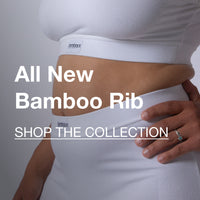Types of Sweaters - Best Materials & When To Wear

The air is crisp, the weather is cool, and the leaves are changing from beautiful hues of green and yellow to mesmerizing shades of gold and crimson. Can you feel it? It’s sweater weather! But with so many options, how do you know which materials are best?
It’s time to get excited — we’re here to go over the many different types of sweaters and their materials to help you find one that’s right for you. Whether you’re on the hunt for something snug and cozy or prefer a fit that’s soft and lightweight — start here.
Different Sweater Materials and When To Wear Them
Not to get confused with a sweatshirt, hoodie, or jacket, a sweater is a knit or crocheted garment for the upper body that can be layered as an undergarment or worn as a fashion statement all on its own. It can be a pullover or open in the front with zippers or buttons.
The yarns used to make a sweater can be made of just about anything, but here are some of the best materials:
Wear Wool for Warmth
When it comes to sweater fabrics, wool is a longstanding favorite — and it’s easy to see why. The coveted material is incredibly durable and deliciously soft. The strong natural fibers of wool are commonly derived from sheep, but wool fabric for sweaters can also be made from the fleece of other animals like rabbit’s angora and alpaca.
These animals are typically bred and raised for their cozy coats. When their hair is long enough, they get a haircut, producing a nice coat for people and a fresh haircut for the summertime for the goat/alpaca/llama/sheep. This thread is then used to knit wool clothing, such as a sweater.
When to wear: If you live in a cooler climate, a warm wool sweater is excellent for keeping the chills at bay. The fiber can sometimes be a bit itchy, though, so you may want to layer it over a long-sleeve shirt or turtleneck.
Choose Cashmere for Style
Cashmere is a type of wool that many people consider it in a class all its own. The popular fabric is often put in a different category from wool because it’s one of the softest, most highly sought-after materials for sweaters. Made from specific breeds of goats, cashmere is lightweight yet still offers incredible softness and insulation.
When to wear: If you’re shooting for luxury, cashmere is a high-end natural fiber that can’t be beat. Versatile and warm without being bulky, this fabric is ideal for fall, winter, and even spring. Throw it on over your favorite comfortable bra, and you’re ready to slay all day!
Call on Cotton for Comfort
Ah, cotton, how we love you so. This natural plant-based fiber is grown all over the world and used to make a variety of things — including t-shirts, underwear, and of course, sweaters. Cotton fibers are strong, soft, absorbent, easy to wash, and affordable, making it a super popular choice among sweater lovers everywhere.
When to wear: The weaves and designs can vary greatly, so thicker cotton versions are good choices when the temperature drops. That said, cotton tends to be a cooler fabric than wool or cashmere, so you can also rock this material in the spring and summer — just opt for lightweight cotton options like a cardigan or open-front sweater.
Pro Tip: For the highest quality, ethically produced cotton, look for the OEKO-TEX certification, which you’ll find here at tomboyx. This means that every single cotton-based textile and treatment we use is guaranteed safe, responsible, and sustainable.
Keep It Simple With Synthetics
Throughout most of history, sweaters have been made from naturally occurring fibers like wool, cashmere, and cotton. However, while consumer demand for fabric has gone up, the amount of these natural resources available has not. Also, many synthetic fibers can be made faster and offer unique properties to those traditionally found in nature.
Due to this, many manufacturers have swapped to man-made options that closely mimic natural materials. These are called synthetics.
When to wear: Since there are so many different types of synthetic fabrics, you can pretty much wear this material anytime that tickles your fancy.
- Acrylic is a synthetic fiber that’s lightweight, soft, and warm, making it a perfect base material for outdoor athletic apparel.
- Spandex is here for you if you’re going on a run or need a little extra comfort factor. For low-key athletics like yoga or a pre-brunch hike, rely on the Peak Low Impact Bra. The bra body is 30% Spandex (and 70% polyester) for a bra that stretches with you. Then, add in the 83% nylon and 17% Spandex mesh lining. You have a bra that’s machine washable, fit-tested, snug yet supportive, and totally cute. Plus, it’s OEKO-TEX certified.
- Hoping for something soft and silky? Opt for a sweater made from rayon.
- Polyester is another popular choice and is especially great for rainy days as it’s known to have moisture-wicking properties. We love polyester, especially recycled polyester. We combine recycled polyester with organic cotton in garments like the Eco Fleece Shirt Jacket. We love it, and the environment does too!
Fall in Love With TENCEL™ Modal
TENCEL™ Modal is a type of rayon that — as we discussed previously — is a synthetic fiber. But TENCEL™ Modal is made from natural materials, so it’s technically a sustainable textile and, therefore, worthy of getting some love.
Made from the wood pulp of renewable beech trees, which require minimal irrigation and zero chemicals or pesticides, TENCEL™ Modal is a semi-synthetic and breathable material that has become increasingly popular over the years.
Why? Simple: It has a luxurious appearance and a soft feel, making it a choice that’s not only affordable but undeniably comfortable, too.
In other words, it’s a perfect material for sweaters — as well as underwear, bras, tanks, joggers, and more!
When to wear: This luxe, soft, and slightly stretchy eco-friendly material can be worn year-round. Slip into a cozy sweater made from this fabric when you don’t want to compromise style for comfort. Wear with our temperature-regulating and certified environmentally-friendly undergarments to stay extra cool.
Mix It Up With a Blend
Last on the list, but certainly not least, we have sweaters made from various blends of fibers, such as cotton and wool, which give you the best characteristics of each fabric being used.
These blended fabrics are often brought together to make a material that’s lightweight, cool, and with some degree of stretch.
Here’s a quick breakdown of what the most common fibers bring to the table:
- Polyester adds moisture-wicking properties as well as increases resistance to wrinkles, shape retention, and durability
- Spandex adds comfort and stretch
- Rayon adds luster, is less static, and improves moisture absorbency
- Acetate adds shine and boosts drapability
- Wool adds warmth, bulk, and comfort
Linen boosts breathability and adds moisture-wicking properties
- Nylon boosts strength, stretch, and abrasion resistance
Elastane adds comfort and stretch to athletic wear
- Angora adds fluffiness
- Silk adds softness, cool comfort, and prestige
- Cotton increases absorbency, boosts comfort, adds warmth, and lessens static
- Acrylic improves softness and adds a wool-like feel
- Tencel boosts absorbency, reduces wrinkles, and adds comfort (hence why we use it here at tomboyx!)
When to wear: As you can see, there are a ton of different types of fabrics that can be used in a blend. When shopping for a sweater to keep warm in the winter, opt for a fabric blend of cotton and wool. Prefer a lightweight sweater that’s soft to the touch? Choose an acrylic-cotton blend or even a polyester-cotton-rayon blend.
Want a sweater that’s as soft as cotton but has low heat retention making it ideal for hot weather? Look for TENCEL™ Modal. Cotton and Spandex are also good choices for something with a bit more stretch.
Conclusion
And there you have it — the many different types of materials used to make sweaters and when to wear them.
Whether you decide to rock a cardigan, tunic, pullover, or V-neck, these fabrics surely won’t disappoint. Just be sure to take special care of your sweater and the fabric used to ensure longevity and comfort.
Not sure where to shop for the coziest sweaters and garments? Check us out here at tomboyx. From our iconic Black Rainbow Trunks and matching undies to the coolest loungewear around, you can always count on us to have just what you need to feel and look your best!
Sources:
Don’t Sweat It: How Moisture-Wicking Fabrics Keep You Cool and Dry | inChemistry
Cashmere Goat Association | CGA
What OEKO-TEX® Labels Mean and Why They Matter
Synthetic Threads | Science History Institute
wool | animal fibre | Britannica






